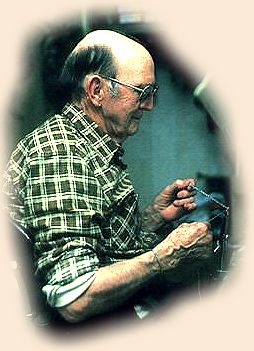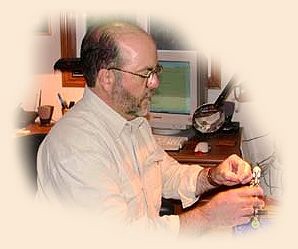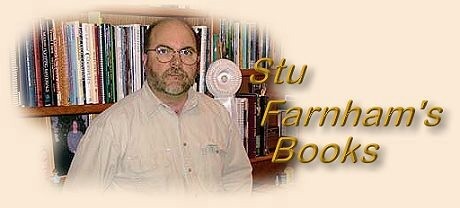|
The Internet is a powerful resource. It provides us instant
access to information, and brings us together via email,
bulletin boards, chat rooms, and instant messaging. FAOL
is a wonderful example of the Internet at its best. The Internet,
however, will never replace the printed page.
I've loved books and fishing since my youngest years, although
I did not start fly fishing until 1993. This column will give
me an opportunity to share reviews of some of my favorite fly
fishing and tying books (and some that are not such favorites)
with my friends here at FAOL. My library reflects my tastes
and interests, and so will this column. It will be heavily
slanted towards cold water fishing and tying for trout and
steelhead, and won't touch much on areas of which I know little,
such as warm or salt water fishing.
I hope that these reviews will motivate some of you to pick up
a good book, on this or any subject, and read.
~ Stu Farnham
Tying and Fishing the Fuzzy Nymph
 Tying and Fishing the Fuzzy Nymph
Tying and Fishing the Fuzzy Nymph
E.H. 'Polly' Rosborough
Hardcover, 192 pages
4th Edition (January 1989)
Stackpole Books
ISBN: 0811718182
This is the last in the series of four reviews that started
with Dave Hughes' Wet Flies and went on to discuss
the works Dave cites as influences: Syl Neme's books on soft
hackles, Jim Leisenring's and Pete Hidy's The Art of Tying
the Wet Fly and Fishing the Flymph, and now Polly
Rosborough's book describing the fuzzy nymphs for which he
is famed.
Polly's name is always spoken with a certain reverence here in
Oregon. Born in California, he lived in Chiloquin along the
Williamson River in Southern Oregon. The Williamson and the
nearby Wood are low-gradient, spring fed streams, and they
influenced Polly's style of tying as much as the limestone
waters of the Letort influenced Vince Marinaro or the brawling
waters of the Yellowstone area guided the fly patterns of Charlie
Brooks. Polly's patterns are long, graceful, and always tied
un-weighted. His dubbing noodle method of constructing bodies
gives a distinct segmentation.
Rosborough learned to tie at a time before the proliferation of
fly shops and the widespread availability of commercial tying
materials. As a result, Polly includes instructions for preparing
and dyeing dubbing and hackle, and his fly recipes specify the
materials he prepared for himself. Detailed instructions for
tying the Muskrat Nymph provide a good introduction to the
methods used in tying Polly's other patterns.
 The bulk of the book contains recipes for eighteen of Rosborough's
twenty-five fuzzy nymphs. Polly's patterns were developed to
imitate the local hatches of southern Oregon. Some of those
hatches, such as the giant salmonfly, occur in many places
throughout the West. Others, such as Hexegenia Limbata, are
more localized, occurring in pockets throughout the country
(the other locale of which I am aware that features Hex hatches
is the upper Midwest, where these large yellow mayflies are known
as 'Michigan caddis'). Still others, such as his Muskrat Nymph,
are attractor patterns of proven effectiveness in many waters.
The bulk of the book contains recipes for eighteen of Rosborough's
twenty-five fuzzy nymphs. Polly's patterns were developed to
imitate the local hatches of southern Oregon. Some of those
hatches, such as the giant salmonfly, occur in many places
throughout the West. Others, such as Hexegenia Limbata, are
more localized, occurring in pockets throughout the country
(the other locale of which I am aware that features Hex hatches
is the upper Midwest, where these large yellow mayflies are known
as 'Michigan caddis'). Still others, such as his Muskrat Nymph,
are attractor patterns of proven effectiveness in many waters.
The recipes are organized into chapters around the order of insect
(or class of prey) being imitated. There are chapters on mayflies,
damselflies, caddis, stoneflies, shrimp & scuds, and 'food
flies' - Rosborough's name for attractor patterns. The sections
describing each pattern describe some of the history of the patterns,
the occurrence and behavior of the insect being imitated, and provide
detailed tying instructions. The single drawback of this book is the
lack of illustrations. The chapters are accompanied by a few ink
drawings or black and white photographs. Two color plates show
forty-five of Polly's flies (the 25 fuzzy nymphs plus some dry
flies), but without much detail.
The final chapter of the book talks about tackle, and then goes
on to discuss Polly's methods for fishing his fuzzy nymphs.
Discussions of presentation are often solely in the context of
fishing the dry fly. Nymphing presentation is limited to dead
drift techniques. Rosborough talks about his favorite active
presentations for the nymphs he preferred to fish.
Next week: a change of pace: Tom McGuane's The Longest
Silence: a Life in Fishing. ~ Stu Farnham
About Stu
 Stu Farnham is a New Englander by birth, who was transplanted to
and put down roots in Oregon in the early 1990s. A software
engineering manager by vocation, he can be found in his spare
time chasing trout and steelhead in the rivers of the Pacific
Northwest, chasing his four Gordon Setters (who in turn are
chasing chukar), tying flies, reading, or working on his website.
Colleen, his long suffering wife of 28 years, is a professionally
trained personal chef.
Stu Farnham is a New Englander by birth, who was transplanted to
and put down roots in Oregon in the early 1990s. A software
engineering manager by vocation, he can be found in his spare
time chasing trout and steelhead in the rivers of the Pacific
Northwest, chasing his four Gordon Setters (who in turn are
chasing chukar), tying flies, reading, or working on his website.
Colleen, his long suffering wife of 28 years, is a professionally
trained personal chef.
|

 Tying and Fishing the Fuzzy Nymph
Tying and Fishing the Fuzzy Nymph Stu Farnham is a New Englander by birth, who was transplanted to
and put down roots in Oregon in the early 1990s. A software
engineering manager by vocation, he can be found in his spare
time chasing trout and steelhead in the rivers of the Pacific
Northwest, chasing his four Gordon Setters (who in turn are
chasing chukar), tying flies, reading, or working on his website.
Colleen, his long suffering wife of 28 years, is a professionally
trained personal chef.
Stu Farnham is a New Englander by birth, who was transplanted to
and put down roots in Oregon in the early 1990s. A software
engineering manager by vocation, he can be found in his spare
time chasing trout and steelhead in the rivers of the Pacific
Northwest, chasing his four Gordon Setters (who in turn are
chasing chukar), tying flies, reading, or working on his website.
Colleen, his long suffering wife of 28 years, is a professionally
trained personal chef.
 The bulk of the book contains recipes for eighteen of Rosborough's
twenty-five fuzzy nymphs. Polly's patterns were developed to
imitate the local hatches of southern Oregon. Some of those
hatches, such as the giant salmonfly, occur in many places
throughout the West. Others, such as Hexegenia Limbata, are
more localized, occurring in pockets throughout the country
(the other locale of which I am aware that features Hex hatches
is the upper Midwest, where these large yellow mayflies are known
as 'Michigan caddis'). Still others, such as his Muskrat Nymph,
are attractor patterns of proven effectiveness in many waters.
The bulk of the book contains recipes for eighteen of Rosborough's
twenty-five fuzzy nymphs. Polly's patterns were developed to
imitate the local hatches of southern Oregon. Some of those
hatches, such as the giant salmonfly, occur in many places
throughout the West. Others, such as Hexegenia Limbata, are
more localized, occurring in pockets throughout the country
(the other locale of which I am aware that features Hex hatches
is the upper Midwest, where these large yellow mayflies are known
as 'Michigan caddis'). Still others, such as his Muskrat Nymph,
are attractor patterns of proven effectiveness in many waters.